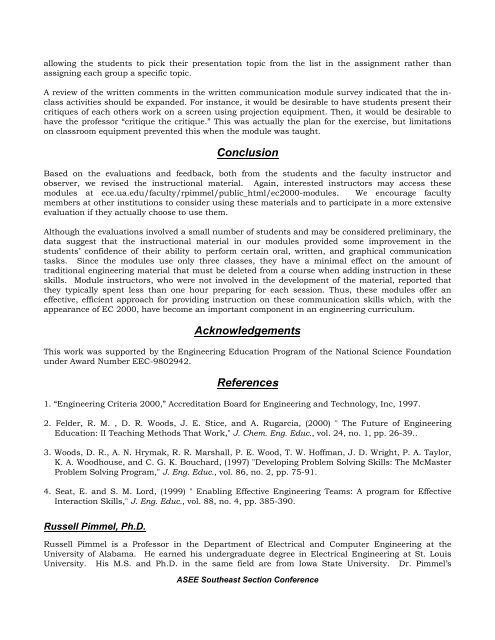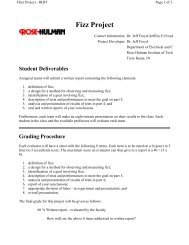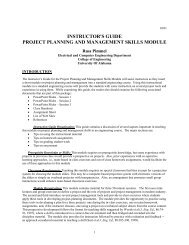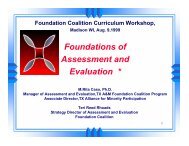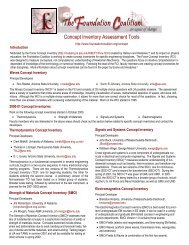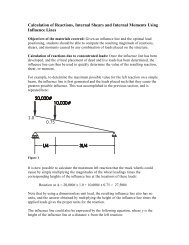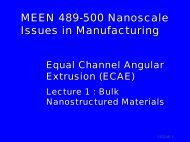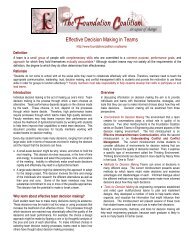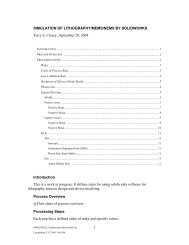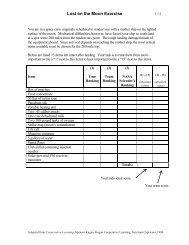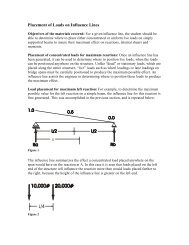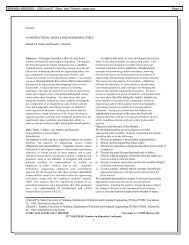Instructional Modules for Teaching Written, Oral, and Graphical ...
Instructional Modules for Teaching Written, Oral, and Graphical ...
Instructional Modules for Teaching Written, Oral, and Graphical ...
Create successful ePaper yourself
Turn your PDF publications into a flip-book with our unique Google optimized e-Paper software.
allowing the students to pick their presentation topic from the list in the assignment rather thanassigning each group a specific topic.A review of the written comments in the written communication module survey indicated that the inclassactivities should be exp<strong>and</strong>ed. For instance, it would be desirable to have students present theircritiques of each others work on a screen using projection equipment. Then, it would be desirable tohave the professor “critique the critique.” This was actually the plan <strong>for</strong> the exercise, but limitationson classroom equipment prevented this when the module was taught.ConclusionBased on the evaluations <strong>and</strong> feedback, both from the students <strong>and</strong> the faculty instructor <strong>and</strong>observer, we revised the instructional material. Again, interested instructors may access thesemodules at ece.ua.edu/faculty/rpimmel/public_html/ec2000-modules. We encourage facultymembers at other institutions to consider using these materials <strong>and</strong> to participate in a more extensiveevaluation if they actually choose to use them.Although the evaluations involved a small number of students <strong>and</strong> may be considered preliminary, thedata suggest that the instructional material in our modules provided some improvement in thestudents’ confidence of their ability to per<strong>for</strong>m certain oral, written, <strong>and</strong> graphical communicationtasks. Since the modules use only three classes, they have a minimal effect on the amount oftraditional engineering material that must be deleted from a course when adding instruction in theseskills. Module instructors, who were not involved in the development of the material, reported thatthey typically spent less than one hour preparing <strong>for</strong> each session. Thus, these modules offer aneffective, efficient approach <strong>for</strong> providing instruction on these communication skills which, with theappearance of EC 2000, have become an important component in an engineering curriculum.AcknowledgementsThis work was supported by the Engineering Education Program of the National Science Foundationunder Award Number EEC-9802942.References1. “Engineering Criteria 2000,” Accreditation Board <strong>for</strong> Engineering <strong>and</strong> Technology, Inc, 1997.2. Felder, R. M. , D. R. Woods, J. E. Stice, <strong>and</strong> A. Rugarcia, (2000) " The Future of EngineeringEducation: II <strong>Teaching</strong> Methods That Work," J. Chem. Eng. Educ., vol. 24, no. 1, pp. 26-39..3. Woods, D. R., A. N. Hrymak, R. R. Marshall, P. E. Wood, T. W. Hoffman, J. D. Wright, P. A. Taylor,K. A. Woodhouse, <strong>and</strong> C. G. K. Bouchard, (1997) "Developing Problem Solving Skills: The McMasterProblem Solving Program," J. Eng. Educ., vol. 86, no. 2, pp. 75-91.4. Seat, E. <strong>and</strong> S. M. Lord, (1999) " Enabling Effective Engineering Teams: A program <strong>for</strong> EffectiveInteraction Skills," J. Eng. Educ., vol. 88, no. 4, pp. 385-390.Russell Pimmel, Ph.D.Russell Pimmel is a Professor in the Department of Electrical <strong>and</strong> Computer Engineering at theUniversity of Alabama. He earned his undergraduate degree in Electrical Engineering at St. LouisUniversity. His M.S. <strong>and</strong> Ph.D. in the same field are from Iowa State University. Dr. Pimmel’sASEE Southeast Section Conference


